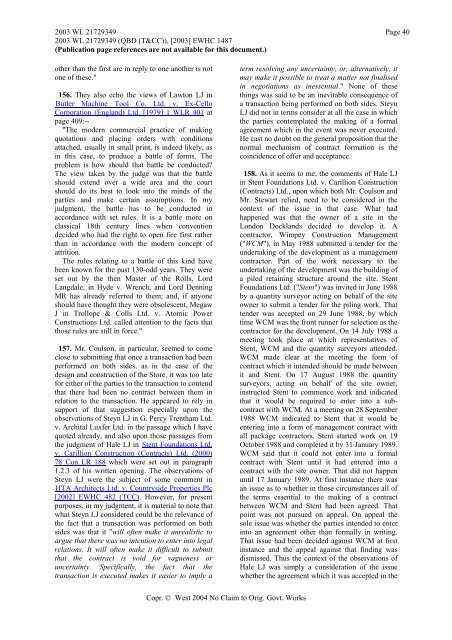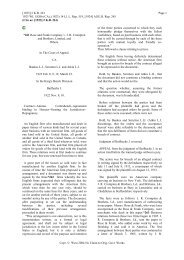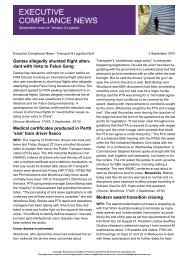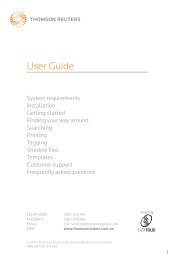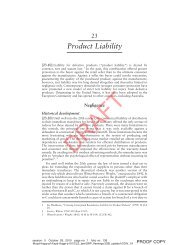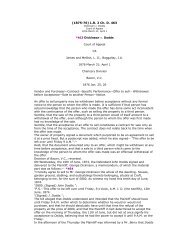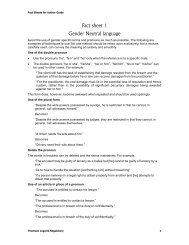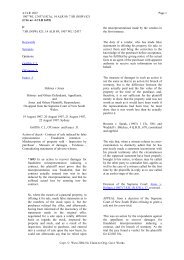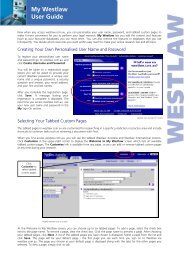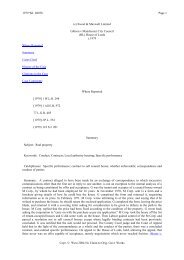Tesco v Constain - Thomson Reuters
Tesco v Constain - Thomson Reuters
Tesco v Constain - Thomson Reuters
You also want an ePaper? Increase the reach of your titles
YUMPU automatically turns print PDFs into web optimized ePapers that Google loves.
2003 WL 21729349 Page 402003 WL 21729349 (QBD (T&CC)), [2003] EWHC 1487(Publication page references are not available for this document.)other than the first are in reply to one another is notone of these."156. They also echo the views of Lawton LJ inHButler Machine Tool Co. Ltd. v. Ex-CelloCorporation (England) Ltd. [1979] 1 WLR 401 atpage 409:--"The modern commercial practice of makingquotations and placing orders with conditionsattached, usually in small print, is indeed likely, asin this case, to produce a battle of forms. Theproblem is how should that battle be conducted?The view taken by the judge was that the battleshould extend over a wide area and the courtshould do its best to look into the minds of theparties and make certain assumptions. In myjudgment, the battle has to be conducted inaccordance with set rules. It is a battle more onclassical 18th century lines when conventiondecided who had the right to open fire first ratherthan in accordance with the modern concept ofattrition.The rules relating to a battle of this kind havebeen known for the past 130-odd years. They wereset out by the then Master of the Rolls, LordLangdale, in Hyde v. Wrench, and Lord DenningMR has already referred to them; and, if anyoneshould have thought they were obsolescent, MegawJ in Trollope & Colls Ltd. v. Atomic PowerConstructions Ltd. called attention to the facts thatthose rules are still in force."157. Mr. Coulson, in particular, seemed to comeclose to submitting that once a transaction had beenperformed on both sides, as in the case of thedesign and construction of the Store, it was too latefor either of the parties to the transaction to contendthat there had been no contract between them inrelation to the transaction. He appeared to rely insupport of that suggestion especially upon theobservations of Steyn LJ in G. Percy Trentham Ltd.v. Archital Luxfer Ltd. in the passage which I havequoted already, and also upon those passages fromthe judgment of Hale LJ in HStent Foundations Ltd.v. Carillion Construction (Contracts) Ltd. (2000)78 Con LR 188 which were set out in paragraph1.2.3 of his written opening. The observations ofSteyn LJ were the subject of some comment inHTA Architects Ltd. v. Countryside Properties Plc[2002] EWHC 482 (TCC). However, for presentpurposes, in my judgment, it is material to note thatwhat Steyn LJ considered could be the relevance ofthe fact that a transaction was performed on bothsides was that it "will often make it unrealistic toargue that there was no intention to enter into legalrelations. It will often make it difficult to submitthat the contract is void for vagueness oruncertainty. Specifically, the fact that thetransaction is executed makes it easier to imply aterm resolving any uncertainty, or, alternatively, itmay make it possible to treat a matter not finalisedin negotiations as inessential." None of thesethings was said to be an inevitable consequence ofa transaction being performed on both sides. SteynLJ did not in terms consider at all the case in whichthe parties contemplated the making of a formalagreement which in the event was never executed.He cast no doubt on the general proposition that thenormal mechanism of contract formation is thecoincidence of offer and acceptance.158. As it seems to me, the comments of Hale LJin Stent Foundations Ltd. v. Carillion Construction(Contracts) Ltd., upon which both Mr. Coulson andMr. Stewart relied, need to be considered in thecontext of the issue in that case. What hadhappened was that the owner of a site in theLondon Docklands decided to develop it. Acontractor, Wimpey Construction Management("WCM"), in May 1988 submitted a tender for theundertaking of the development as a managementcontractor. Part of the work necessary to theundertaking of the development was the building ofa piled retaining structure around the site. StentFoundations Ltd. ("Stent") was invited in June 1988by a quantity surveyor acting on behalf of the siteowner to submit a tender for the piling work. Thattender was accepted on 29 June 1988, by whichtime WCM was the front runner for selection as thecontractor for the development. On 14 July 1988 ameeting took place at which representatives ofStent, WCM and the quantity surveyors attended.WCM made clear at the meeting the form ofcontract which it intended should be made betweenit and Stent. On 17 August 1988 the quantitysurveyors, acting on behalf of the site owner,instructed Stent to commence work and indicatedthat it would be required to enter into a subcontractwith WCM. At a meeting on 28 September1988 WCM indicated to Stent that it would beentering into a form of management contract withall package contractors. Stent started work on 19October 1988 and completed it by 31 January 1989.WCM said that it could not enter into a formalcontract with Stent until it had entered into acontract with the site owner. That did not happenuntil 17 January 1989. At first instance there wasan issue as to whether in those circumstances all ofthe terms essential to the making of a contractbetween WCM and Stent had been agreed. Thatpoint was not pursued on appeal. On appeal thesole issue was whether the parties intended to enterinto an agreement other than formally in writing.That issue had been decided against WCM at firstinstance and the appeal against that finding wasdismissed. Thus the context of the observations ofHale LJ was simply a consideration of the issuewhether the agreement which it was accepted in theCopr. © West 2004 No Claim to Orig. Govt. Works


